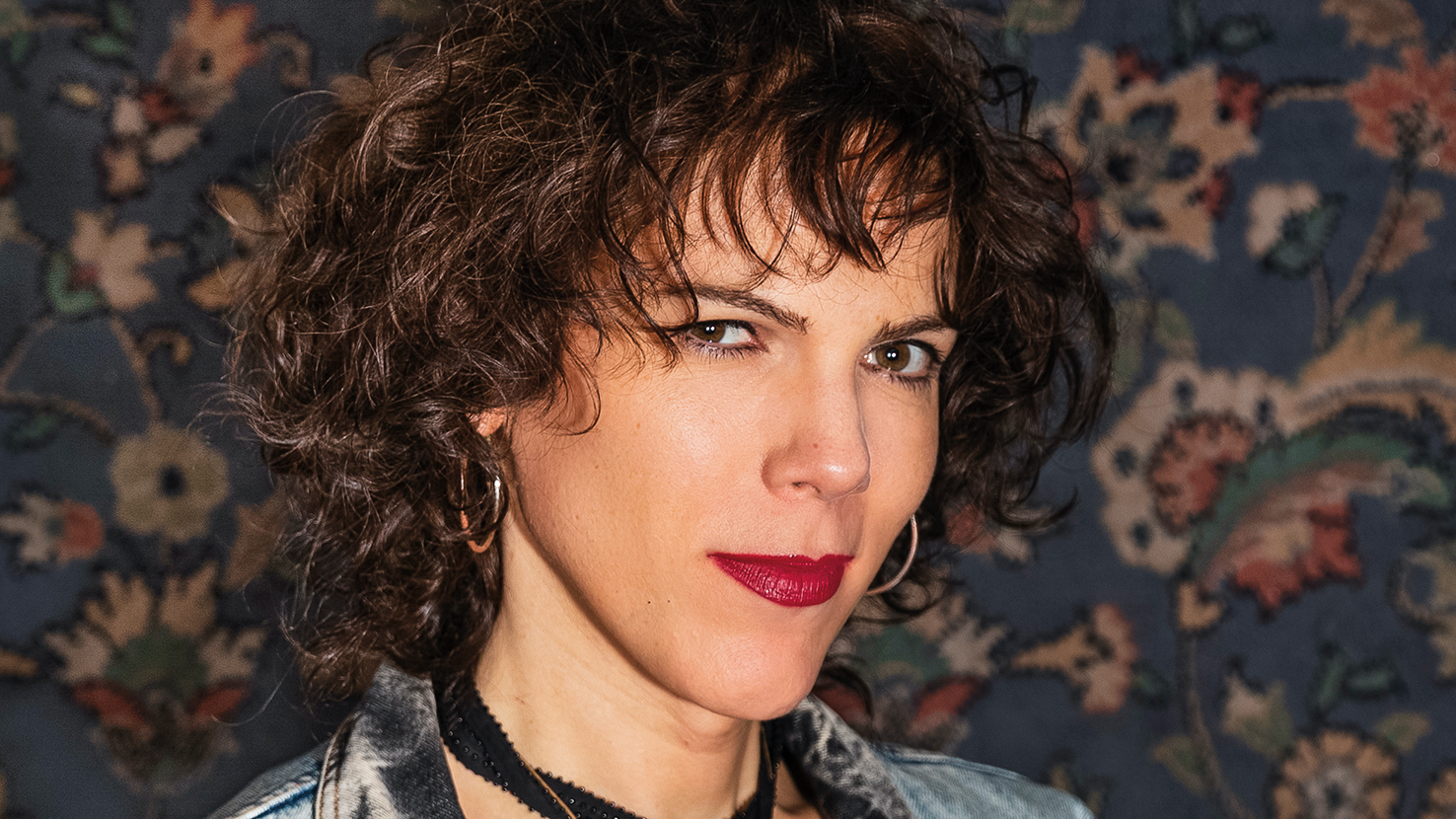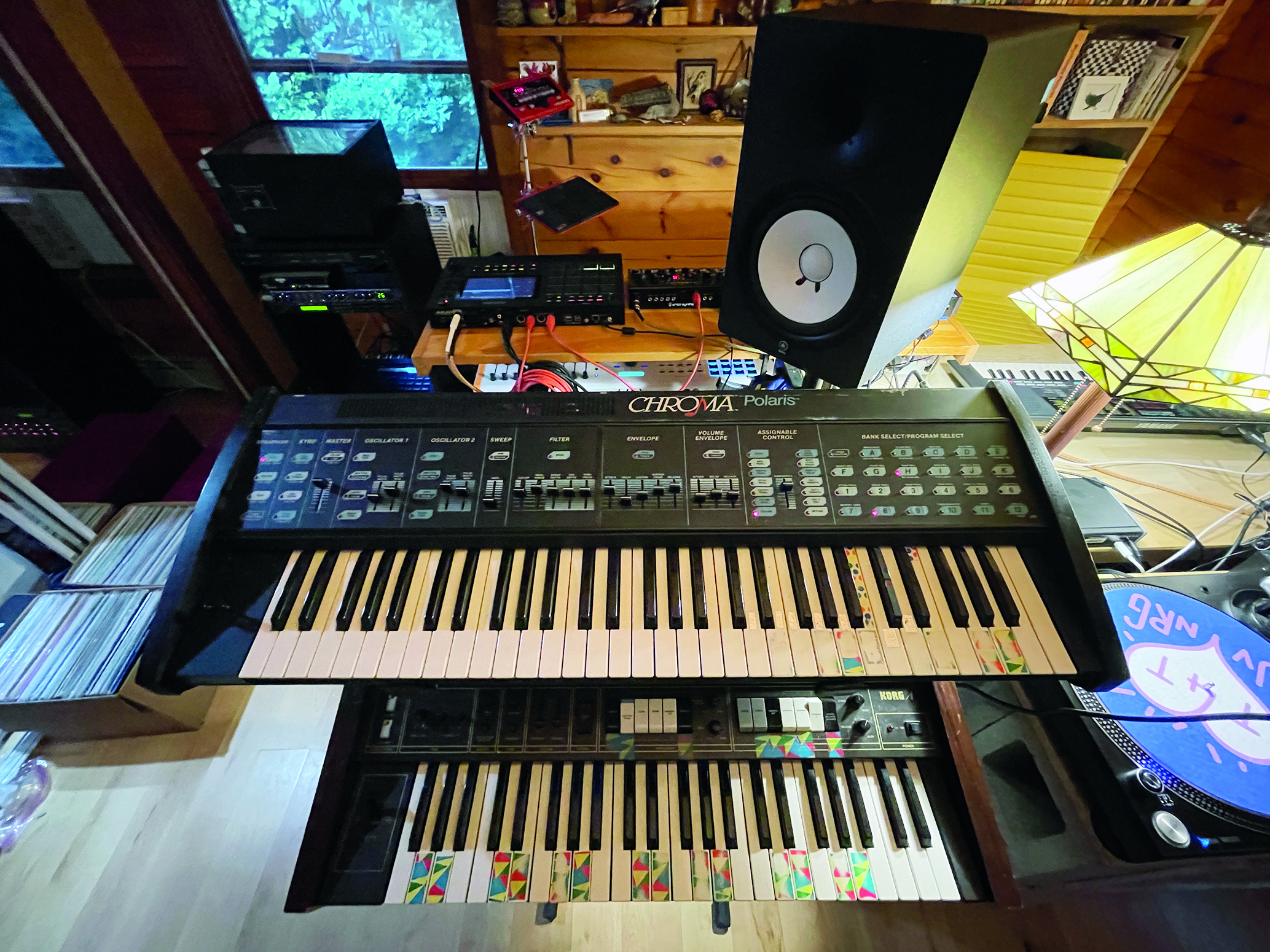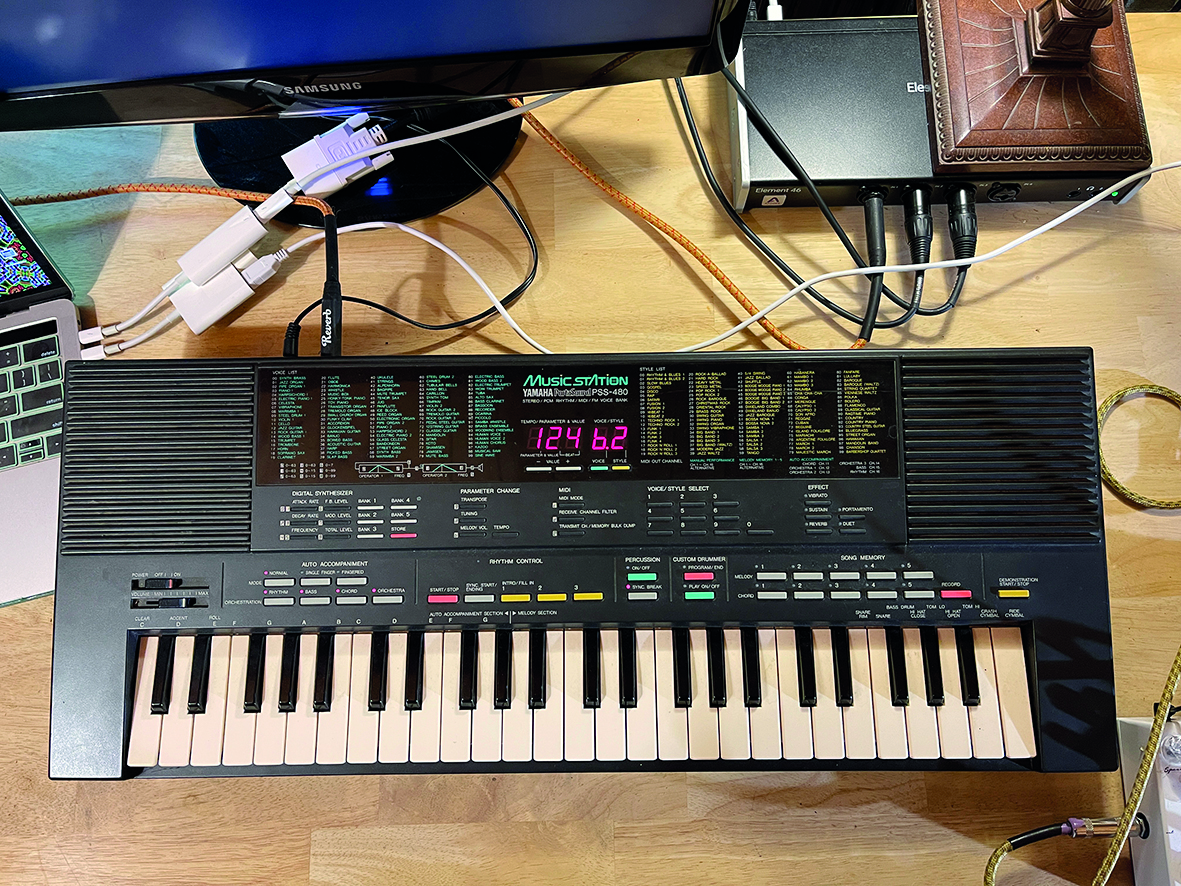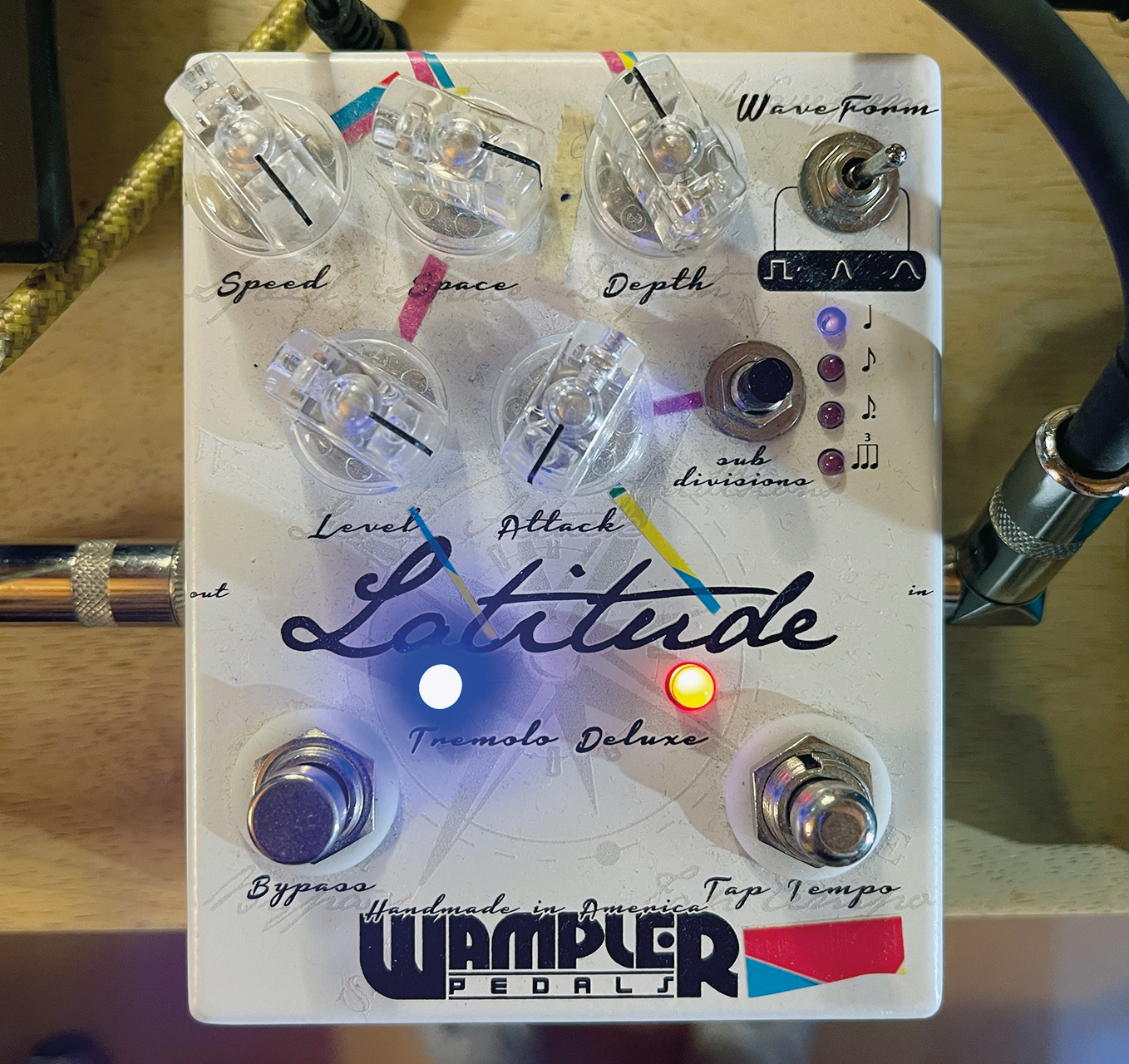Eris Drew: "It was cool to like Guns N’ Roses and sh*t like that, but there was I with my Depeche Mode shirt listening to house music mixes on the radio late at night"
One of the few DJs still performing with turntables, house producer Eris Drew also uses her Technics as a production tool. We take a deep dive into her debut album

In common with many DJs, the pandemic obliterated Eris Drew’s schedule, which had recently expanded to almost a hundred gigs globally.
So Drew took the bold decision to trade her hometown of Chicago for a secluded forest cabin in New Hampshire, living with production and label partner Octo Octa (Maya Bouldry-Morrison), and started work on her debut album.
Titled Quivering In Time, Drew’s solo effort feels not too dissimilar to her DJ sets, fast-moving percussion-heavy dancefloor tunes alight with upbeat party vibes.
With her tracks built from a stack of vinyl samples, Drew added kicks, scratches, vocal samples, hand-played keyboard riffs and percussion to recreate the communal euphoria of a club scene slowly returning to life.
Tell us about the move from Chicago to New Hampshire on the US east coast…
“The practical story is that I fell in love and wanted to move here, but there’s a spiritual story too, as for years I dreamt of having a life where I could be in nature and make music but still have some connection to cities and DJing."
It was cool to like Guns N’ Roses and shit like that, but there was I with my Depeche Mode shirt listening to house music mixes on the radio late at night
"As a Chicago girl, the move seemed so irrational to me because the music I make is so in the bones of the city and leaving seemed something distant for my older years, but I fell in love with Maya who grew up here and ended up in rural New Hampshire in a log cabin. I look out my window now and it’s just forest.”
Get the MusicRadar Newsletter
Want all the hottest music and gear news, reviews, deals, features and more, direct to your inbox? Sign up here.
Your partner Maya published a DIY guide to building a home studio. Has that helped you both settle into this new environment?
“I wouldn’t say the guide was related to that, but it’s the first time I found an environment where I shared a studio in a space with someone else, so there was constant collaboration and discussion about music. The cabin itself really does affect our music-making experience because it’s kind of like setting up shop inside the body of a guitar. It’s an extremely resonant space.
"My subwoofer is on an all-timber floor and I’ve got slats above me that bounce the sound around. It’s an extremely warm-sounding environment that colours the sound, but as a songwriter I love it. We’re not so remote that we don’t have any home comforts and there’s a generator in the basement that we only need to run in emergencies.”
Presumably, at odds with your previously hectic Chicago lifestyle?
“I’d been in Chicago for so long and it’s a tough town but I’m so grateful for my experiences. Having lived in the city for 25 years you get to kind of know everybody, but the club scene is tricky there now because it’s shrunk quite a bit.
"There are only a few venues and party crews that support this kind of music, so even though Chicago is huge, it feels like a small city because a lot of people want to work but aren’t able to.”

In Chicago house music has receded in popularity and certain venues are closing…
“I could probably write a book on it. One chapter would be about gentrification, the changing of the neighbourhoods and pushing out of venues, but there’s also been a change in the music scene. I’d always hear the house-heads saying that by the late ’90s the music had really changed and I can’t say that’s wrong.
"There’s been less focus globally on what people were doing in Chicago and more of the big commercial clubs got to be popular. The whole bottle service thing was huge in the late ’90s and ’00s and that’s been very pervasive too. If it wasn’t for Smartbar and some of these other places, there wouldn’t be anywhere to have that true, elevated house music experience.
"Another factor is the legal environment because they passed the rave ordinance in the late ’90s, which basically made it really easy for police to stop parties. Not only could they fine a venue or promoter, but they could fine the DJ and that chilled the hell out of everyone because they could potentially be subjected to a $10,000 penalty. People still do it, but you either have to keep things really small or have connections.”
Music’s not my way of expressing the dark side of my psyche; it’s more about transforming it
Your label’s called T4T LUV NRG. Were you a fan of the original Hi-NRG sound?
“I love Hi-NRG music and the sound that always pops into my head is NRG’s He Never Lost His Hardcore, which was very rave. Being in Chicago, the proto-house sound was very much based on European imports like Euro disco, Italo, NY electro and older disco records.
"Patrick Cowley’s Hi-NRG sound was also very much in the air. My mum loved all that music – she was a huge Sylvester fan, and not just the big songs but all the 12” mixes. We used to jam out to Take Me To Heaven in the car.”
So your parents were the source of your love of disco and dance music?
“I was a little kid living in Minnesota in the ’70s and my parents liked to go disco dancing at night. They’d get a babysitter, go out early and, as far as I can tell, found a pretty good club because they had a neat, idiosyncratic collection. The first disco record I remember hearing was C.J. & Company’s Devil’s Gun, which is a pretty dope underground record.
"My parents were straight, white people, but from a young age my mum told me, ‘If you wanna really hear good music Eris, you gotta go places where there are black folks and gay folks’. That was a good thing to hear in the early ’80s because I was ridiculed for my music tastes as a kid.
"It was cool to like Guns N’ Roses and shit like that, but there was I with my Depeche Mode shirt listening to house music mixes on the radio late at night.”

What was your general mindset when it came to creating what is your debut album?
“I’d been thinking a lot about how I wanted it to be structurally. I love albums so much and felt like I wanted to do a dance album that was different to all the others. When 12” artists go to make an album it’s so often about having guest appearances, collaborations or songs they wouldn’t necessarily play on a dancefloor.
"I wanted an album that was programmed, hyper-arranged and I guess it’s clichéd to say it but a journey from front to back. A few examples would be Orbital’s The Brown Album, 808 State’s ex:el or Run DMC’s Tougher Than Leather, which all have quite a bit of evolution within them.”
It definitely has a celebratory tone. Was that a reaction to the global circumstances?
“I started writing a couple of songs on tour – just little drum samples and working on chords and melodies. When we went into quarantine I had one track called Quivering At The End Of Time, which was a reference to the psychedelic notion that maybe a historical period was ending."
I wanted to make a very hefty and bassy record but one that still had a lot of clarity and dynamics
"I had no idea that I was about to head into lockdown, but I thought it was a prescient moment. I didn’t want to just write an album that’s dark; music’s not my way of expressing the dark side of my psyche; it’s more about transforming it.”
Trying to turn a negative into a positive?
“Well, it’s not like I’ve been out here in the woods all happy over the past 18 months – our music careers suddenly came to a slamming halt. Having toured the world in 30 countries, Maya and I were on a real high.
"We’re both transgender women who’d felt a whole lot of triumph and momentum, so it felt like we were telling a freight train to stop. From all of that frustration and feelings of loss – and even though I was feeling quite depressed, I wanted to take all of the positive energy of the last year and a half and cast it back into the music.”
Are you now able to view your enforced break from live shows as an inadvertent positive?
“All I know is that I took the time to record an album, something I never thought I’d have time to do. Also, I was not what I would consider an engineer. I would mix down my tracks as best I could, but on the previous Fluids of Emotion EP I got the opportunity to work with an amazing sound engineer in Detroit called BMG.
"We spent two weeks working together, not just to engineer the record but so I could use the time to create my own engineering practice. It was very hands-on and we were both behind the controls, so I learned a lot about things like compression and balance.”

The production is very accomplished so you appear to have learned a lot in a short time.
“I wanted to make a very hefty and bassy record but one that still had a lot of clarity and dynamics, so it gave me the chance to do all the trial and error I needed to get my ears and skills in shape.
"But I have to say that Maya and I must have listened to these songs a thousand times in the car and talked about them, so she’s kind of the ‘executive producer’. I would work on the songs, bounce them out and listen to them in the car, on headphones and the laptop. They call it A/B-ing, but I was A/B/C/D-ing and did that for a solid year and a half.”
The album almost replicates a DJ set. The energy is relentless, yet each track is independent of another. Did you think about blending it all together?
“Each track should flow into one another but I hadn’t thought of making it fully continuous. I’m very much a DJ at heart and like to be able to look at the vinyl, see the clean start and play the track from the first beat. I wrote 12 songs and knocked them down to 9, and part of that was based on how we thought the songs flowed and not wanting to repeat certain themes."
If I had to put it simply it’s keyboard jams to my DJing with added post-production
"It also feels like DJing because of the way I make music. I use samplers but not necessarily in the way everybody else does because I use turntables instead of timestretching.
"The average vinyl DJ is working in a 0- 8% time change range – and there are a few Technics decks where you can switch between 8-15% – but mine are (+/-) 50% and I really take advantage of that.”
How do you use turntables to make a track?
“I start with a simple beat collage, which comprises of a few different rhythms that I’m mixing together. I’ll lay one down and mix over it while doing some multi-tracking in the computer.
"Then I get out my keyboards and start to write, so the songs are still individualised because I have a songwriter’s approach. I don’t use step sequencers, everything is sequenced in real-time and I’ll often work on chords on the piano. If I had to put it simply it’s keyboard jams to my DJing with added post-production.”

So you’re using turntables to play the initial beats and multi-layering them in the DAW?
“The first part is pretty simple. I’ll find a little beat or a part of a beat and pick a song tempo, so instead of randomly sampling beats into the computer and changing the pitch to match whatever I decided the tempo is going to be, I’ll make that decision up front.
"That first beat goes in and I might cut that up and repeat it over a few measures, then I’ll grab another record and do what I’d normally do in a set, which might be to drop in a snare at a weird place.
"For example, the track Baby has all these snare drops at the start but I didn’t swing those, the legato comes from me throwing them in a little bit late by scratching and dropping snare drums from different tracks.
"One of my techniques is to adjust the record’s speed, so I might record the snare at its normal pitch or really pitch it down, up or at half-time, so there’s tons of half-time and double-time breaks all over the record and they’re created on-the-fly rather than detuned in the computer.”
Do you prefer to create quite a rough mix with all the inaccuracies that may come from sampling included?
“There is plenty of editing that happens in the computer afterwards, but it’s really just editing it so the sounds are where I intended them to be. For example, if I scratched a scratch a little late then I’ll just move it to where I wanted it to be.
"But the recordings are the recordings, so they have noise in them and timing issues because I used a lot of live drum samples, but I don’t get fussy about that. The records I loved have tons of samples doing their own thing and it’s that funk and energy that gives them a feel that’s so different to a lot of modern music.”
Many of the tracks have vocal samples, where are you sourcing them from?
“On the title track, I used samples from a series called The Ultimate Skratch Record, which were these battle records that were very popular with house DJs."
I don't like to use typical sounds [...] one track has a hippo growling at one point amongst a bunch of Run DMC drops
"That’s kind of unusual as we tend to think of battle records coming from hip-hop, but some were made in Chicago that had lots of beats and samples from house songs but also classic hip-hop samples. For example, there’s a sample on Quivering In Time that sounds like a girl saying ‘bass’, but it’s actually Chuck D sped up.
"I don’t like to use typical sounds. That track starts with quite dry Florida breaks plus a ‘hah’ hip-hop beat, but the next sound you hear, which sounds like a shaker, is actually the tremolated sound of a meadow, and one track has a hippo growling at one point amongst a bunch of Run DMC drops – so there’s all kinds of stuff in there.”
Will you add in percussive elements using drum machines or software-based tools?
“Yes, I have a few rompler-style drum machines that I love and have used for years. I used a Roland R-8 MKII from the ’80s, which is arguably their last great drum machine.
"It has wonderfully clean 808 and 909 sounds and they’re very particular. I also used a drum machine called the Yamaha RM50 and played some drums using my Nord Drum 2, which I love because, unlike the romplers, it has a synth brain and you can synthesise sounds from the ground up like you would with a Moog.
"I do use some softsynths too and really like D16’s Drumazon and Nepheton, which are 808 and 909 clones. They’re great units for when I need a clean sound really fast. I like it when one second a sound is dirty but the next sound has really clean hats or kick drums.
"That’s why I love Run DMC’s Tougher than Leather album, because one second you have these really great rock ‘n’ roll samples and then a really clean 808 comes in over them.”

Are you still a vinyl collector or do you feel there’s not enough new vinyl being produced that’s worth sampling from these days?
“We went to see my parents and brought my collection back with me, which we think is about 6,000 records. We have off-site storage and one of our projects over quarantine was to go through my entire collection, organise it by year and start putting it into Discogs.
"Most of my samples are from older records; I can’t think of a single sample that I used from a record made by a producer that’s working today. I’m a 100% vinyl player on tour and there’s very few of us left. I’ve been doing this so long and have developed such a skill when it comes to mixing with turntables that I don’t want to let it go.
"My mum was an antique dealer and told me not to believe that every time something’s considered as progress it actually is. It’s worth mentioning that I sample off CDs too and keep an old DVD player in my studio hooked up to my mixer.”
When did you first get into playing keyboards?
“The earliest experience I remember was in my grandmother’s basement because my grandfather had one of those old player pianos. You put a scroll in and could make it sound so demented by controlling the pedal. My grandmother also got me a little Casio toy when I was in third grade and I loved this little thing."
That’s what I started to teach myself synthesis on – stuff like Depeche Mode, Information Society and industrial music
"Once I had a little of my own money I went to a store called Service Merchandise that had the Yamaha PortaSound synth series and I’ve still got the PSS-480 in front of me now. It’s a two-operator FM synth with nine controls that you can use to change the sound, store five sounds and it’s got a five-track sequencer on it, which was a lot for $100.
"That’s what I started to teach myself synthesis on – stuff like Depeche Mode, Information Society and industrial music. I wanted to be in a band that made that kind of music, but I love the keyboard to this day.
"It’s a noisy little bugger, but on the song A Howling Wind every single synth sound is from it because it has great singular tones. My hallmark synthesiser is the Chroma Polaris…”
The mid-‘80s analogue Fender/Rhodes synth?
“Yes and there’s a neat history there. ARP was basically going out of business and they came up with this polysynth that they’d already designed. It’s an analogue synth with an ARP sound and a digital stepping filter.
"It’s the opposite of how everyone wanted to structure a synth at the time as it has really wonderful digital oscillators with an analogue filter, which gives it such a wild and different sound because when you filter it has to do these little digital ’80s calculations.
"The opposite of that would be my Yamaha rack unit – the TX816, which is basically eight DX7s in a box. It gives you the cleanest tones you can imagine for when you want something that sounds like it’s coming out of a video game.”

What DAW/plugins are you using these days?
“Logic 10, because I just need a glorified tape recorder that can run plugins in time code. I’m more of a player than a programmer, so I’ll draw some dynamics automation and programme hi-hats, but it’s mostly volume changes and some wet/dry effects.
"I use some pedals for processing. I’ve got a Lexicon rack, which I haven’t used in a while, but I keep a little pedal array and when it’s time to work on a keyboard part I might run them through one of those. My favourites are a little tremolo plugin and a delay plug called an Aqua-Puss.”
Do you see your immediate future as a producer rather than DJ?
“The UK’s been open for about nine weeks now and I’ve been touring for eight of them. The second we get off the phone I’m jumping in a car to go play a three-day rave in upstate New York, so we are back at it and my schedule’s absolutely full until the end of the year.
"Production-wise, if I’m moving around a lot I’ll create collages, put them together on the road and engineer them when I get back. With varying success [laughs].”
Eris Drew's favourite gear
Roland R-8
“The Roland R-8 drum machine from the 1980s is my go-to for clean drum hits. The MKII comes with 808/909 samples that can be deeply edited on the fly.”
Fender Chroma Polaris
“For an organ tone with sonic possibilities of a synth, I love playing my Fender Chroma Polaris, which has six analogue voices and a stepping ’80s digital filter.”
Pioneer PLX-1000
“My favourite turntable is the Pioneer PLX-1000 as I can adjust the pitch of an analogue recording by a factor of 50% (+/-) without a digital sampler.”
Wampler Latitude Deluxe
“Many dance producers use gates, but I prefer creating rhythms and movement with tremolos like the Wampler Latitude Deluxe analogue pedal at the last stage of a delay line.”
Yamaha PortaSound PSS-480
“I bought the PortaSound PSS-480 at a toy store in 1988. With only two operators per sound, basic controls and early DACs, the sounds are simple, noisy and very FM.”
Eris Drew’s forthcoming album Quivering In Time is released 29 October on T4T LUV NRG.


“I have an original 909 – every time I try to use it I feel like I’m ruining it”: House hero Riva Starr on his studio essentials and his love of analogue synths
“I’m looking forward to breaking it in on stage”: Mustard will be headlining at Coachella tonight with a very exclusive Native Instruments Maschine MK3, and there’s custom yellow Kontrol S49 MIDI keyboard, too









